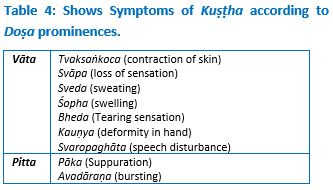Clinical Importance of the knowledge of Ṣadkriyākāla w.s.r. to Kuṣṭha Samprāpti
Keywords:
Kriyākāla, Importance, Kuṣṭha, Nidāna, SamprāptiAbstract
Ayurveda believes that healthy person stay healthy by equalizing the Doṣas, Dhātus and Malas. The concept of Kriyākāla advocated by Suśruta Samhitā. Kriyākāla refers to the recognition of the stage of a disease's progression. It is also referred as Cikitsā Avasara (opportunity to treat). Kriyā means Cikitsā (treatment) and Kāla refers to the stage of progression of a disease. The knowledge of Kriyākāla helps to determine appropriate therapy to correct the imbalance in Doṣas in early stage. In Ayurveda, most of the skin diseases have been described under the broad heading of Kuṣṭha. In the present study, concept of Kriyākāla is tried to elaborate with the special reference of Kuṣṭha Samprāpti. Aim & Objective: To study the samprāpti of Kuṣṭha in accordance to concept of Kriyākāla. Material & Methods: Material has been collected from Suśruta Saṁhitā with various commentaries, Research articles, and electronic databases. Discussion: Early detection of diseases and its progress will help to cure the Disease with minute efforts. However if the Disease will progress it might be difficult to treat. And later on it become incurable. In the same way on young plant can be uprooted completely whereas the same plant is allowed to grow as a big tree cannot uproot easily. Kuṣṭha is Cirakālīna (chronic) Tridoṣaja Vyādhi manifested on Tvak (skin) if untreated later on it intrude to all Dhātus. Conclusion: This article will help in to understand the journey of Kuṣṭha Vyādhi from its Nidānasevan to Samprāpti in accordance with the stage of Ṣadvidh Kriyākāla.
Downloads
References
Malakiya Chintankumar, Naik Nikita, Kanabar Abhay, Bhakkad Bhushan, Patankar Lokesh; Analytical Views on Practical Utility of Kriyakala in Clinical Practice; International Ayurvedic Medical Journal; July 2021; ISSN: 2320-5091
Suśruta. Suśruta Saṁhitā, ‘Ayurveda tattva sandīpikā’ hindi commentary by Shastri AD, Part- I (Sutra, Nidāna, Śārira, Cikitsā, Kalpa sthānas), Chaukhambha Sanskrit Sansthan, Varanasi- 221001, 2014
Malakiya Chintankumar,Naik Nikita, Kanabar Abhay, Bhakkad Bhushan, Patankar Lokesh; Analytical Views on Practical Utility of Kriyakala in Clinical Practice; International Ayurvedic Medical Journal; July 2021;ISSN: 2320-5091
Malakiya Chintankumar,Naik Nikita, Kanabar Abhay, Bhakkad Bhushan, Patankar Lokesh; Analytical Views on Practical Utility of Kriyakala in Clinical Practice; International Ayurvedic Medical Journal; July 2021;ISSN: 2320-5091
Divya Naik, Aniruddha; Application of Kriyakala in Kaphaja Vikara – A Review Article; International Journal of Ayurveda and Pharma Chemistry; Volume-15 (Issue- 2) 2021; ISSN 2350-0204
Vivekanand B. Mastamardi; Ayurvediya Roga Vigyana evum Vikriti Vigyana Part-1; published by Chaukhambha Vishvabharati, Varanasi 221001
Vivekanand B. Mastamardi; Ayurvediya Roga Vigyana evum Vikriti Vigyana Part-1; published by Chaukhambha Vishvabharati, Varanasi 221001















